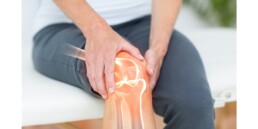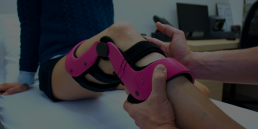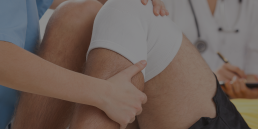Have you ever had to bend down to pick up something, and have trouble getting up straight away and without wincing? You may be suffering from joint pain (sometimes called polyarthralgia), just like nearly 4 million Canadians according to this ACREU report. With very uncomfortable pains in everyday life, these joint problems can limit your activities, as well as impact your mental health in the long term. In this article, we explain the different causes of joint pain, and existing treatments to relieve it.
Arthritis, the big family of joint pain
The word arthritis is composed of the prefix “arthro” meaning “joint”, and the suffix “itis” meaning “inflammation”. It’s a general term that encompasses any form of tissue inflammation, whether acute or chronic, and which can affect one or more joints. Arthritis includes at least a hundred different pathologies such as osteoarthritis, fibromyalgia, rheumatoid arthritis, etc. Often of unknown origin, arthritis comes mainly from an autoimmune reaction. This causes the secretion of substances that gradually destroy the structure of the joint.
Osteoarthritis, the main cause of joint pain
Joint pain is most often due to osteoarthritis, the most common joint disease in the large arthritis family. Two types are distinguished:
- primary osteoarthritis: no direct link with a lesion of the joint;
- secondary osteoarthritis: the cartilage of the affected joint has been previously damaged by trauma or disease.
Osteoarthritis is due to the wear of the cartilages which extends to all the structures of the joint, in particular to the bone and the synovial tissue. When the cartilage is healthy, it lines the bony ends of the joint, allowing them to slide past each other without friction. In the case of osteoarthritis, the cartilage is permanently destroyed: it loses thickness, cracks and eventually disappears. This leads to friction during movement and progressive pain. In the most serious cases, there may be a total loss of mobility, representing a major handicap.
The causes of joint pain
Non-modifiable risk factors :
- Sex and hormones: female sex hormones (estrogens) play a protective role against osteoarthritis. However when menopause strikes, the lack of estrogen production may lead to joint pain.
- Genetics: certain areas of osteoarthritis, in particular the hand and the knee, may be more frequent in certain families.
- Metabolic disorders (obesity, diabetes, etc.): obesity is a major risk factor for osteoarthritis of the knee (gonarthrosis), but also of the hip. Good news: weight loss, even moderate, protects the joint (losing about 5 kilos reduces the risk of knee osteoarthritis by 50% for 10 years). Diabetes is also an emerging risk factor. Several articles highlight the harmful role of excess sugar on cartilage deterioration.
Modifiable risk factors
If there are risks over which we have no control, we can act on others:
- diet;
- smoking;
- type of job;
- excess weight;
- physical inactivity ;
- joint trauma (often in athletes);
- tendons or ligaments inflammations;
- infection or disease (gout = inflammatory arthritis caused by the formation of crystals in the joints).
Symptoms of joint pain
- limitation of range of motion;
- stiffness (30 min) when getting up;
- redness and warmth in the affected limb;
- swelling or loss of flexibility in the affected joint;
- appearance of bony bumps on the joints of the fingers;
- weight-bearing pain in the leg joints (hip, knees, ankles);
- grinding sensation or cracking sound when the joint moves.
Although symptoms may come and go, the disease is progressive: the pain may get worse over time.
Complications related to joint pain
The main complications caused by arthritis are:
- swelling in the joint due to fluid buildup;
- muscle spasms due to lack of movement;
- stiffness due to muscle contraction resulting from inactivity;
- swelling of the tissues close to the joint (pain on palpation and on movement);
- deformity of certain limbs, in the fingers and feet, occurring in advanced stages.
Solutions and treatments to consider in case of joint pain
Taking analgesics
So far there are only symptomatic solutions (pain relief) for the treatment of arthritis/osteoarthritis. Among the analgesics prescribed to fight against pain, paracetamol is still very effective. In the event of an attack, nonsteroidal anti-inflammatory drugs (NSAIDs) administered orally or in the form of a gel or ointment are also useful. If you prefer to use natural anti-inflammatories, blackcurrant is a very effective superfood to consider to relieve your ailments. We recommend that you always consult your doctor before taking any medication or painkillers.
Other therapeutic approaches
- joint lavage;
- lose weight if necessary;
- injection of hyaluronic acid;
- avoid carrying heavy loads;
- practice regular and moderate physical activity outside of inflammatory flare-ups (e.g. walking for 30 minutes to 1 hour, 3 times a week).
Wearing an orthosis to relieve osteoarthritis of the knee
Among seniors, osteoarthritis of the knee is a widespread pathology, which can quickly become disabling. EVO offers a personalized treatment to find the orthosis you need to regain your mobility. Following a precise diagnosis, the process of choosing the orthosis, designed entirely to measure, is initiated. Make an appointment now, and get your health and mobility back!
Joint pain: what you need to remember
- Some risk factors are irrevocable, while we can act on others and introduce change in our lives (sedentary lifestyle, obesity, diet, etc.);
- Women in the menopause phase are more affected, in particular because of the drop in estrogen production;
- The existing solutions mainly relieve the pain (anti-inflammatories) but do not treat the root cause of the problem;
- Orthosis can be a solution to effectively relieve knee osteoarthritis.
Share this article
Related posts
December 3 2021
Osteoarthritis of the knee: how to recognize the symptoms?
December 6 2019
Orthosis for knee osteoarthritis treatment
April 14 2018
New Treatments Against Osteoarthritis
Unsteadiness, vertigo, persistent sensation of fall, these symptoms are often the cause...


